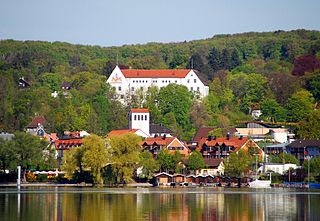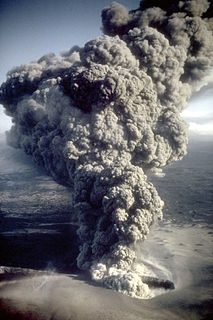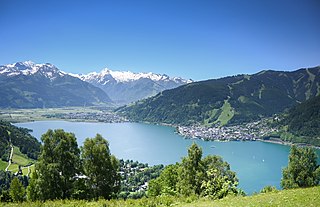
Lake Constance refers to three bodies of water on the Rhine at the northern foot of the Alps: the Obersee or Upper Lake Constance, the Untersee or Lower Lake Constance, and a connecting stretch of the Rhine, called the Seerhein. These waterbodies lie within the Lake Constance Basin, which is part of the Alpine Foreland and through which the Rhine flows.
Plön is a district in Schleswig-Holstein, Germany. It is bounded by the districts of Ostholstein and Segeberg, the city of Neumünster, the district of Rendsburg-Eckernförde, the city of Kiel and the Baltic Sea.

Neustrelitz is a town in the Mecklenburgische Seenplatte district in the state of Mecklenburg-Vorpommern, Germany. It is situated on the shore of the Zierker See in the Mecklenburg Lake District. From 1738 until 1918 it was the capital of the duchy of Mecklenburg-Strelitz. From 1994 until 2011 it was the capital of the district of Mecklenburg-Strelitz.

The Havel is a river in north-eastern Germany, flowing through the German states of Mecklenburg-Vorpommern, Brandenburg, Berlin and Saxony-Anhalt. It is a right tributary of the Elbe and 325 kilometres (202 mi) long. However, the direct distance from its source to its mouth is only 94 kilometres (58 mi).
Vulkaneifel is a district (Kreis) in the northwest of the state Rhineland-Palatinate, Germany. It is the least densely populated district in the state and the fourth most sparsely populated district in Germany. The administrative centre of the district is in Daun. Neighboring districts are Euskirchen, Ahrweiler, Mayen-Koblenz, Cochem-Zell, Bernkastel-Wittlich, and Bitburg-Prüm.

Starnberg is a German town in Bavaria, Germany, some 30 kilometres (19 mi) southwest of Munich. It is at the north end of Lake Starnberg, in the heart of the "Five Lakes Country", and serves as capital of the district of Starnberg. Recording a disposable per-capita income of €26,120 in 2007, Starnberg regained its status as the wealthiest town in Germany.

A maar is a broad, low-relief volcanic crater caused by a phreatomagmatic eruption. A maar characteristically fills with water to form a relatively shallow crater lake which may also be called a maar. The name comes from a Moselle Franconian dialect word used for the circular lakes of the Daun area of Germany. Maars are shallow, flat-floored craters that scientists interpret as having formed above diatremes as a result of a violent expansion of magmatic gas or steam; deep erosion of a maar presumably would expose a diatreme. Maars range in size from 60 to 8,000 m across and from 10 to 200 m deep; most maars commonly fill with water to form natural lakes. Most maars have low rims composed of a mixture of loose fragments of volcanic rocks and rocks torn from the walls of the diatreme.

Cambs is a municipality in the Ludwigslust-Parchim district, in Mecklenburg-Vorpommern, Germany.

Lake Starnberg, or Starnberger SeeGerman pronunciation (help·info)) — called Lake Würm, or Würmsee, until 1962 — is Germany's second-largest body of fresh water, having great depth, and fifth-largest lake by area. It and its surroundings lie in three different Bavarian districts, or Landkreise. The lake is property of the state and accordingly managed by the Bavarian Administration of State-Owned Palaces, Gardens and Lakes.

Zell am See is the administrative capital of the Zell am See District in the Austrian state of Salzburg. The town is an important tourist destination known as Zell am See-Kaprun and is a transportation hub for the region.

Mirow is a town in the district of Mecklenburgische Seenplatte in southern Mecklenburg-Vorpommern, Germany.

Senftenberg is a town in southern Brandenburg, Germany, capital of the Oberspreewald-Lausitz district.

Lake Bohinj, covering 318 hectares, is the largest permanent lake in Slovenia. It is located within the Bohinj Valley of the Julian Alps, in the northwestern Upper Carniola region, and part of Triglav National Park.

The Großer Plöner See or Lake Plön is the largest lake (30 km²) in Schleswig-Holstein, Germany. It is located near the town of Plön. Its main tributary, as well as its main outflow, is the River Schwentine.

Lessy is a commune in the Moselle department in Grand Est in north-eastern France.

Lake Kummerow is a lake in the Mecklenburgische Seenplatte district, Mecklenburg-Vorpommern, Germany. At an elevation of 0.3 m, its surface area is 32.55 km². Its outflow is the Peene. It is situated southwest of Demmin. It is named after the village Kummerow on its southern shore.

Schmöckwitz is a German locality (Ortsteil) within the Berlin borough (Bezirk) of Treptow-Köpenick. Until 2001 it was part of the former borough of Köpenick.

A Zungenbecken, also called a tongue basin or tongue-basin, is part of a succession of ice age geological landforms, known as a glacial series. It is a hollow that is left behind by the ice mass, as the snout of the glacier recedes, which initially fills with meltwater, forming a proglacial lake, and later may be filled with surface water from streams or precipitation. When the glacier has more fully retreated this produces a finger lake or glacial piedmont lake. The term Zungenbecken is of German origin, but used in English language sources.

















